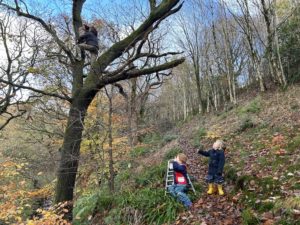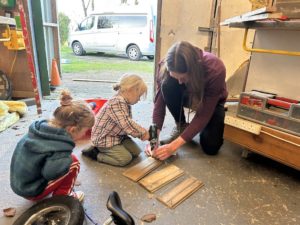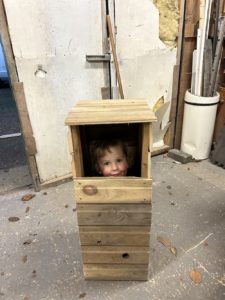In the second instalment of her new monthly column, Amy Liptrot and her young family think like owls.

Since we moved to this house four years ago, I often hear tawny owls in the evening: the ‘huhuhuhooo’ of a male on territory, sometimes answered by a female ‘t-wit’. I have never seen one but the hooting lets me know they are out there, in the woods at the end of the street.
I hear about a friend-of-a-friend in Sheffield who put up an owl nest box in her garden and owls came and nested! I want an owl too. The owls in ‘our’ woods might welcome a new place of shelter, so I plan to make a box with the kids. Tawny owlets hatch in April or May and first eggs are laid at the end of March. Adults are on territory earlier, pairing up over the winter, so we must get started now.
Ready made nest boxes and kits are available but we decide to make our own as a family project. We cut up some old fence panels, then screw them together to make a 30cm square tube with a hole at the top, mimicking the tree cavities where tawnies like to nest. The kids help with some drilling and enjoy seeing it come together.

Representations of owls are everywhere. A quick look in a local gift shops finds owl greeting cards, owl lightshades, owl mugs, owl egg cups and owl Christmas tree baubles. These illustrations are often far removed from the reality of owls as wild animals and predators. But real owls are out there. This area, Calderdale, is one of the few where it is possible to see all five British species of owl: tawny, barn, little, long-eared and short-eared.
The kids and I prepare for installing the box by reading owl storybooks and watching owl videos. I join a local owl spotting Facebook group. We look for a location in the woods, trying to think like an owl — where looks private and protected? Is there prey available — mice or voles? The box needs to be installed on a mature tree, at least 3m high, facing SE away from prevailing winds, and as far from disturbance as possible.
Then, on a dull Saturday, we carry out the mission: carrying the heavy box, a ladder and tools into the woods, feeling illicit. Dom climbs high in one of the trees we’d identified — a twisty oak — and I pass him the box. Then our 4-year-old goes on my shoulders and passes up the drill (a healthy tree will withstand a few holes). Dom manages to attach the box to the tree, wedging himself between trunk and branch, an impressive job. He climbs down and we look up and admire our work, hoping it will be an appealing home.

We made the box as a way to help tawny owls who are experiencing declines in breeding, winter populations and range. We now wait until spring to see if we have been successful at attracting a pair. Or it might be many years. We’ve placed a bit of hope in the treetops, a lofty dream.